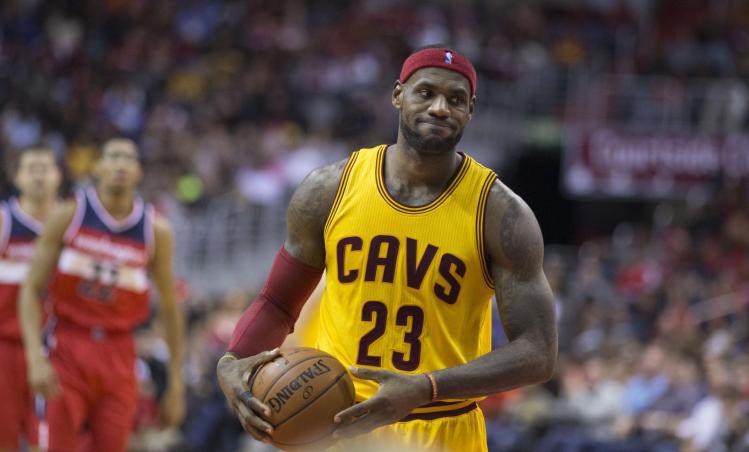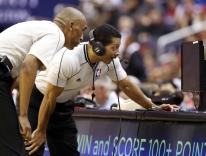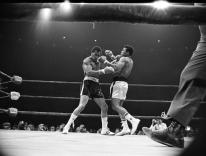
There's a funny moment in Ravelstein, Saul Bellow’s roman à clef about his friendship with the Straussian political theorist Allan Bloom where Bloom/Ravelstein invites his graduate students over to watch some hoops. Bloom, we learn, loves ball: he seldom misses the Chicago Bulls on NBC, and he loves holding court with his academic disciples, occasionally jumping on the phone to gossip with some former student now stationed in the first Bush administration. But what motivates Bloom—a proud snob who deplored rock music for stimulating sensations of transcendence far lower than the true exaltation won by “victory in a just war” or “discovery of the truth”—to invite his groupies over to watch a bunch of men scramble for an inflated cow hide? The answer, of course, starts with Michael Jordan. NBA basketball, for Bloom, offers a stage for excellence amid the ruins of cultural mediocrity. In Jordan, we have an individual who struggles under stadium lights against relentless competition and still achieves genuine transcendence, artistry, and even genius.
I love basketball for the way it dramatizes the power and fragility of all collective action. In basketball, action is elementally unpredictable, and true success requires placing your fate in the hands of your teammates. “One way sports works,” Hanif Abdurraqib writes in his superb new book, There’s Always This Year: On Basketball and Ascension, “is because of the fact that many of us do, in fact, survive on the miracles and mercies of others.” But basketball cooperation does not proceed on equal terms. Nearly everyone reading this can, I hope, conjure a mental image of Michael Jordan. Can you picture his Bulls teammate Dickey Simpkins? Basketball contains both deeply cooperative elements (the greatest teams thrive through balletic feats of coordination) and deeply inegalitarian elements (in no other major sport is the importance of individual superstars more obvious). Shoddy roster construction has kept Mike Trout, the greatest baseball player of his generation, from ever reaching the second round of the playoffs; LeBron James has led deep postseason runs flanked by some truly unremarkable players.
So it makes some sense that Allan Bloom was attracted by feats of individual nobility and virtuosity in this particular game. Indeed, even those of us who are committed democrats and egalitarians reach for aristocratic language when we talk hoops. What will Kevin Durant’s playoff exit mean for his legacy? Do the Denver Nuggets have the making of a dynasty? And, of course, who really is the greatest of all time? We sometimes seem confused about what we want from this sport. Everyone loves an underdog, but we also clamor for dynastic greatness—even if we later come to hate it. We want intemperate upstarts, and we want kings.
In There’s Always This Year, Abdurraqib, the MacArthur Award–winning poet, essayist, and cultural critic, reveals that he knows something Bloom didn’t: basketball is not really like Roman gladiator games. All sorts of people play basketball, after all—with ragged balls and new ones, with chain nets and no nets, in school gyms, local YMCAs, and neighborhood parks. No colosseum required. One of the things Abdurraqib loves about the sport is that it gives so many people—from a middle-aged schoolteacher in a rec league nobly struggling against his own physical decline to a young kid on a playground in Abdurraqib’s hometown of Columbus, Ohio—access to moments of immortality. “We loved MJ,” he writes of his childhood in Columbus, “but there were Michael Jordans on our block…Jordans four houses down, Jordans at the bus stop.” For Abdurraqib, it’s entirely possible to achieve greatness while occupying underdog status. After all, he insists, the “noblest of hoopers” is “the person who made a way with a bald rock, and a little path of concrete that was their concrete.” As an adolescent he adored Columbus’s own state championship–winning Brookhaven High School men’s basketball team, a brash collection of “kids from the city, like all of us,” who crossed swords with a young LeBron James. Coming into the game, Brookhaven was ranked higher than LeBron’s squad, but they were underdogs nonetheless, Abdurraqib insists, because “the streets loved them,” and you are, ultimately, “a reflection of who loves you.” Bearing witness to Brookhaven’s ascension had something of an ennobling effect for those kids sitting in the rafters: it “meant something, even for those of us who were residue in the midst of their greatness.”
But a basketball team cannot save your life. Those who witnessed Brookhaven's ascension are still only residue, after all. And, in the end, those noble Wildcats lose to LeBron. Their coach Bruce Howard, a “pillar of greatness” in Columbus, dies of liver failure less than a month later. Those Jordans of East Columbus, living just blocks away from Abdurraqib’s childhood home? Not all of them made it out. And Abdurraqib himself, who watched LeBron ascend through a series of Ohio gymnasiums, is in jail when the player finally arrives in the NBA. Abdurraqib has become “a spectator in an always-unfolding coronation. Watching through the fence, because you can’t afford a ticket.” And yet, he wants to insist—he must insist—that anyone who has ever ascended on any basketball court, big or small, remains royalty for life. “If you are a champion for a day or even for a few moonlit hours,” he declares, you are a champion. “No one can strip you of this.”
There’s Always This Year is a virtuosic prose performance. This book ascends. Its architecture is flamboyantly ambitious: a memoir of Abdurraqib’s childhood and young adulthood, told alongside an exploration of the career of Lebron James. The book’s structure is meant to resemble that of a single basketball game. It is divided into four “quarters,” and a “game-clock” counts down from twelve minutes, chopping up Abdurraqib’s musings on heartbreak, race, beauty, home, and mortality. Between these covers one can find a sustained quasi-theological meditation on the nature of eternity, a close reading of Otis Redding’s “My Girl,” and a poem describing both LeBron encountering a heckling fan and the phenomenology of running from the cops. The sheer variety of this book’s literary modes and objects of inquiry has led some readers to declare that it is about “more than basketball,” which is true but a little misleading. Basketball is always about more than basketball, but here it is also far more than just a metaphor. Indeed, some of Abdurraqib’s loveliest writing in the book comes when he’s talking ball. Here he is, for example, on dunk contests:
A dunk contest is where one goes to execute some far-flung dream of what the body is capable of. It is where one goes to fail, often spectacularly. I wish all failure could be as beautiful as the failures that arrive to us midair, a reality setting in that we are incapable and yet still in flight.
There’s Always This Year is the product of a writer in full command of his powers. The writing is conversational in that it enlists the second person and bobs around from topic to topic, but I have never had a conversation with someone quite like Abdurraqib. Who do you know who, in conversation, might closely describe a video of a raccoon trying and failing to eat cotton candy as a way to talk about the vibes around Cleveland prior to the Cavaliers’ 2016 NBA championship victory?
Abdurraqib’s prose delicately registers ambiguities but not much ambivalence. He diagnoses the lies we tell ourselves—about our teams, our cities, and our loved ones—but refuses to disavow them. After all, he writes, “Most of the beauty I have surrendered myself to is tucking some far less delicious honesty beneath its magic, and so why not this?” What is ultimately most extraordinary about this book is Abdurraqib’s almost superhuman capacity to feel things—longing and ecstasy, fury and joy—and get the reader to feel them with him. This is a book that’ll have you worrying that your own heart may be two times too small.
Reading Abdurraqib's reflections on love, greatness, and basketball immortality had me engaged in some extended soul searching about Celtics forward Jayson Tatum. Tatum is the best player on my favorite team, but I confess that I sometimes struggle to love him. It’s hard to treat him as any kind of underdog, but it’s also hard to think of him as great. What he is is very good, though perhaps a little dull. I’ve certainly never heard him give an interesting interview in his career. From what I can tell, he’s an amiable teammate and a committed father to his young son, the omnipresent Deuce. Tatum has an athletic frame, but he’s no Giannis Antetokounmpo; he is a fluid shooter, but he’s no Kevin Durant; he is an able enough passer, but he’s no Nikola Jokic. It sometimes seems as if he lacks what basketball pundits call a “killer instinct.” In short, it is relatively rare that he ascends. I doubt Allan Bloom would think much of him. But every year, if not every month, he gets imperceptibly better: adds a couple more pounds of muscle, reads the passing lanes better, is a half a second quicker on his defensive rotations. An able student of the game, Tatum exhibits an abiding commitment to learning from repetition. And he abides: he is hardly ever hurt, scores around thirty points almost every night, and the Celtics usually win.
I feel some guilt about my coolness toward Tatum because it’s partly the result of his remarkable virtues: his constancy and commitment, even his quiet devotion to basketball—such virtues are rarely perceived as extraordinary. (I would also, of course, like him to win us a title.) Virtues like these have a paradoxical quality: they become less perceptible the more profoundly they are realized. There’s a great deal in all our lives that has something of this character. In the background of any human life, there are pearls of decency and nobility that struggle to rise to the surface.
There’s a tragic element to this, of course. One of the profoundly ethical aspects of Abdurraqib’s writing is his commitment to unearthing hidden pearls of kindness and beauty in the midst of pain. He delights in offering what he calls “close readings of pleasure,” taking “great care with rituals some might consider to be quotidian.” He grasps such moments, holds them aloft, and ascends with them toward the rim. But I’d like to finish with Abdurraqib back on the asphalt. Toward the end of his acknowledgements, after thanking friends and editors and before memorializing departed Columbus loved ones, he takes a moment to praise those people who, with constancy and grace, quietly tend to the infrastructure of our lives: “Gratitude to the people who put the nets up at all the parks on the Eastside before those old ’90s summers. Gratitude to the people who swept the glass off the courts. Who painted the lines.” They, no less than Jordan and Tatum, are part of the sport.
Please email comments to [email protected] and join the conversation on our Facebook page.
Previous Story
How Harlem Saw Itself
Next Story
Rejoice in Revolution


